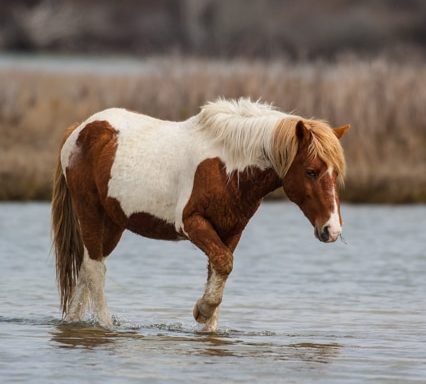Chincoteague Ponies (a.k.a. Assateague horses) are feral ponies that live on Assateague island in Virginia and Maryland. While legend suggests that the ponies are descended from Spanish horses shipwrecked in the 16th century, or abandoned on the island by pirates, it is more likely that their ancestors were brought over by farmers from the mainland in the 17th century.
Currently, the Chincoteague Volunteer Fire Department owns the roughly 150 ponies on the Virginian side and the Maryland Park Service reports that 78 reside on the Maryland side of the island. About 1,000 more live off-island, owned by citizens or breeders. They are generally left alone except for twice-yearly vet inspections, and contraceptives help keep their numbers in check.

The island life is quite harsh, resulting in the ponies having a limited diet consisting of salt water cord grass that grows in the marshes. ClixPhoto.com
The island life is quite harsh, resulting in the ponies having a limited diet consisting of salt water cord grass that grows in the marshes. They must eat constantly to obtain sufficient nutrition, and because the salt content of their diet is very high, they drink twice as much water as normal horses.
Beginning in the 1800s, the ponies and island sheep were rounded up once a year; in 1924, the first official Pony Penning Day was held. Today, the event on the last Wednesday in July attracts 50,000 visitors to watch the Virginia herd from Assateague swim across the channel to Chincoteague Island. There, the larger foals are auctioned off to raise money for the fire department.
The National Chincoteague Pony Association was founded in 1985, and the Chincoteague Pony Registry (open only to horses purchased from the annual auction) was begun in 1994.
Characteristics
The Chincoteague Pony stands between 12-14.2 hands. The head has a straight or slightly concave profile with a broad forehead. Other features include well-angled shoulders, well-sprung ribs, a broad chest, short back and broad loins. Legs are straight and sturdy with dense bone and strong hooves. Abundant manes and tails are common, with fetlocks that are lightly feathered.
These ponies can be found in all solid colours, but those sporting pinto patterns tend to fetch more at auction.
Uses
Once domesticated, Chincoteague ponies are said to be willing and easy to train for trail riding and western or English competition, as well as driving.
For more information about Chincoteague ponies, visit:
National Chincoteague Pony Association
Chincoteague Pony Registry


